- Home
- About
- Map
- Trips
- Bringing Boat West
- Migration West
- Solo Motorcycle Ride
- Final Family XC Trip
- Colorado Rockies
- Graduates' XC Trip
- Yosemite & Nevada
- Colorado & Utah
- Best of Utah
- Southern Loop
- Pacific Northwest
- Northern Loop
- Los Angeles to NYC
- East Coast Trips
- Martha's Vineyard
- 1 Week in Quebec
- Southeast Coast
- NH Backpacking
- Martha's Vineyard
- Canadian Maritimes
- Ocracoke Island
- Edisto Island
- First Landing '02
- Hunting Island '02
- Stowe in Winter
- Hunting Island '01
- Lake Placid
- Chesapeake
- Provincetown
- Hunting Island '00
- Acadia in Winter
- Boston Suburbs
- Niagara Falls
- First Landing '99
- Cape Hatteras
- West Coast Trips
- Burning Man
- Utah Off-Roading
- Maui
- Mojave 4WD Course
- Colorado River Rafting
- Bishop & Death Valley
- Kauai
- Yosemite Fall
- Utah Off-Road
- Lost Coast
- Yosemite Valley
- Arizona and New Mexico
- Pescadero & Capitola
- Bishop & Death Valley
- San Diego, Anza Borrego, Joshua Tree
- Carmel
- Death Valley in Fall
- Yosemite in the Fall
- Pacific Northwest
- Utah Off-Roading
- Southern CA Deserts
- Yosemite & Covid
- Lake Powell Covid
- Eastern Sierra & Covid
- Bishop & Death Valley
- Central & SE Oregon
- Mojave Road
- Eastern Sierra
- Trinity Alps
- Tuolumne Meadows
- Lake Powell Boating
- Eastern Sierra
- Yosemite Winter
- Hawaii
- 4WD Eastern Sierra
- 4WD Death Valley +
- Southern CA Deserts
- Christmas in Tahoe
- Yosemite & Pinnacles
- Totality
- Yosemite & Sierra
- Yosemite Christmas
- Yosemite, San Diego
- Yosemite & North CA
- Seattle to Sierra
- Southwest Deserts
- Yosemite & Sierra
- Pacific Northwest
- Yosemite & South CA
- Pacific Northwest
- Northern California
- Southern Alaska
- Vancouver Island
- International Trips
- Index
- Tips
- Books
- Photos/Videos
- Search
- Contact
Seattle , WA
Tuesday, July 2, 2013 - 7:30am by Lolo
247 miles and 2.5 hours from our last stop - 3 night stay
Travelogue
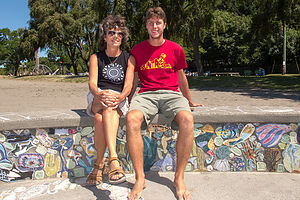 Lolo and Tom at Golden Gardens ParkLike most cities, Seattle does not have a campground within its boundaries, so before heading out on this trip, I searched for campgrounds within a 25 mile radius. We tend to prefer national and state parks to commercial campgrounds, so I was very pleased to discover Saltwater State Park, exactly 23.3 miles from the University District in Seattle, where Tommy was going to be living. Since our stay would overlap 4th of July, just to be safe, I made reservations for a 3-night stay.
Lolo and Tom at Golden Gardens ParkLike most cities, Seattle does not have a campground within its boundaries, so before heading out on this trip, I searched for campgrounds within a 25 mile radius. We tend to prefer national and state parks to commercial campgrounds, so I was very pleased to discover Saltwater State Park, exactly 23.3 miles from the University District in Seattle, where Tommy was going to be living. Since our stay would overlap 4th of July, just to be safe, I made reservations for a 3-night stay.
When we arrived, I was extremely pleased with my selection, so much so, in fact, that I was practically gloating. The park had 1,445 feet of beachfront on the Puget Sound, including a sandy swimming beach, and tide pools that were exposed during low tide. The campground itself was nice as well, nestled in a forested ravine along a creek, and just a short walk from the beach.
Tommy drove down to join us after unloading some of his belongings, and we headed down to the beach with cameras, a cooler, and chairs to watch the sun set over Puget Sound and the Olympic Mountains. It really was quite lovely. I thought I had found the perfect base camp from which to explore Seattle.
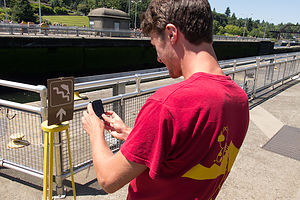 Tom Photographing Jumping Salmon Sign at Chittenden LocksI only later discovered a few issues that made it a bit less than perfect – still pretty darn good – but not perfect.
Tom Photographing Jumping Salmon Sign at Chittenden LocksI only later discovered a few issues that made it a bit less than perfect – still pretty darn good – but not perfect.
Firstly, I was unaware that the park was located along the flight path for jets approaching SeaTac Airport. At first, it was amusing and as each jet roared by overhead, I would point up and say, “Look a plane.” However, after realizing that there was only about a 15 minute interval between planes, this got old pretty quick.
Secondly, and this was my fault, I didn’t realize that our site did not have a water or electrical hookup, so we probably should have filled up with more water before arriving. That would explain why it was only $23 per night.
Thirdly, that 23.3 mile trip to Seattle was not quite as convenient as we thought. During certain times of the day, I5 approaching Seattle is more similar to a parking lot than a highway. We would definitely have to avoid a wide window around rush hour.
Day 1 – Seattle Tour
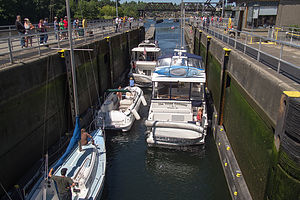 Boats in Chittenden LocksThe next morning, Herb and I set out fairly early to meet up with Tommy in Seattle to do a whirlwind tour of the city. There really are so many great places to see and things to do that we had to limit ourselves to just a few selections that would give us a flavor for what this great city has to offer.
Boats in Chittenden LocksThe next morning, Herb and I set out fairly early to meet up with Tommy in Seattle to do a whirlwind tour of the city. There really are so many great places to see and things to do that we had to limit ourselves to just a few selections that would give us a flavor for what this great city has to offer.
We started off at Green Lake Park, not too far from where Tommy was now living. Rather than just stopping at tourist destinations, I wanted to get a feel for where the locals spend their time. After all, Tommy was now a local, even if for just one day. The park was lovely, and there was so much to do. It was a very bustling place, even on a Wednesday. There are two swimming beaches, one on each side of the lake, and a place to rent kayaks, canoes, and paddleboats. A 2.8 mile paved trail circles the lake and it was filled with joggers, rollerbladers, bicyclists, people walking their dogs, moms pushing strollers, you name it. In addition, there were dozens of people just relaxing in chairs or on blankets watching the action go by. I could definitely picture this as a place to just come and hang out at on a sunny day.
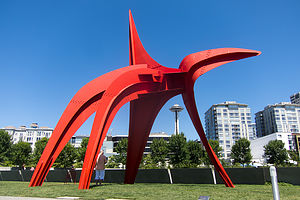 Calder's "Eagle" at the Olympic Sculpture ParkNow that we had experienced a Seattle urban park, we headed west to Golden Gardens Park on the Puget Sound. It was a nice day, and although there were quite a few people on the beach, no one was braving the chilly waters. That’s one thing that I have to say the East Coast has over the West – oceans with swimmable temperatures. However, the West Coast beaches do dominate when it comes to scenic views from your beach blanket; in this case, we the snow-capped Olympic Mountains rising beyond Puget Sound.
Calder's "Eagle" at the Olympic Sculpture ParkNow that we had experienced a Seattle urban park, we headed west to Golden Gardens Park on the Puget Sound. It was a nice day, and although there were quite a few people on the beach, no one was braving the chilly waters. That’s one thing that I have to say the East Coast has over the West – oceans with swimmable temperatures. However, the West Coast beaches do dominate when it comes to scenic views from your beach blanket; in this case, we the snow-capped Olympic Mountains rising beyond Puget Sound.
Chittenden Locks was a very fun stop. I am not sure which was more interesting – watching the boaters and lock-keepers scurrying to get boats securely tied before the locks were raised or lowered, or the salmon, looking equally frenzied as they scrambled to get up the next fish ladder. These locks provide the connection between the saltwater of Puget Sound and freshwater Lake Union and Lake Washington. It is a very busy place, as well as one of the most visited attractions in Seattle.
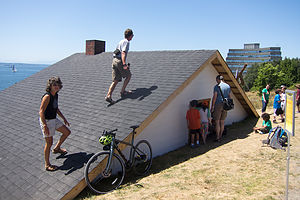 Herb and Lolo on "The Western Oracle: We Will Tear the Roof Off the Mother"While the boats go both to and from the Sound, the salmon are only going one-way – upstream to spawn. After watching a few boats get through the locks, we went to the underwater fish-viewing window to watch the salmon and trout jump up the fish ladders. It is so amazing that they are so programmed to do this, and the ladders make it possible, despite the locks which have blocked their normal passage since 1917.
Herb and Lolo on "The Western Oracle: We Will Tear the Roof Off the Mother"While the boats go both to and from the Sound, the salmon are only going one-way – upstream to spawn. After watching a few boats get through the locks, we went to the underwater fish-viewing window to watch the salmon and trout jump up the fish ladders. It is so amazing that they are so programmed to do this, and the ladders make it possible, despite the locks which have blocked their normal passage since 1917.
The way the ladders work is freshwater is forced to flow swiftly out the bottom of the fish ladder, simulating swimming upstream. When approaching the ladder, the fish smell the water and actually recognize the scent of Lake Washington – now that is pretty impressive. After entering the ladder, they have the choice of either jumping over each of the 21 weirs, or cheating a little and swimming through tunnel-like openings. When they exit, they are in freshwater and ready to continue along the waterway to the exact location where they were born. Then they perform their biological function: females lay eggs, males fertilize them, and then they die. Fortunately, their offspring live on to head out to sea before returning a few years later to repeat the whole process all over again.
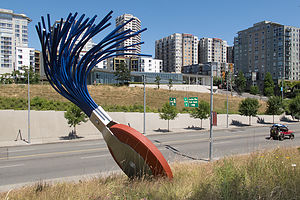 Typewriter Eraser, Scale XI hesitate to even include our attempt at visiting Discovery Park in the narrative, because we just couldn’t figure out where to go and what to do there. It is Seattle’s largest park and is, according to the guide books, a hiker’s paradise. What we should have done is find the Visitor Center to get some maps, but without the maps, we couldn’t even find that. However, based on my readings, if we had done it right, we would have hiked to an incredible view of Puget Sound and the surrounding Olympic and Cascade mountain ranges from the top of Magnolia Bluff. Oh well, maybe next time.
Typewriter Eraser, Scale XI hesitate to even include our attempt at visiting Discovery Park in the narrative, because we just couldn’t figure out where to go and what to do there. It is Seattle’s largest park and is, according to the guide books, a hiker’s paradise. What we should have done is find the Visitor Center to get some maps, but without the maps, we couldn’t even find that. However, based on my readings, if we had done it right, we would have hiked to an incredible view of Puget Sound and the surrounding Olympic and Cascade mountain ranges from the top of Magnolia Bluff. Oh well, maybe next time.
We had a lot more luck with our stop at the Olympic Sculpture Park, a lovely nine-acre outdoor museum overlooking Puget Sound, about a mile north of Pike Place Market. Some of the works were so very familiar, such as Alexander Calder’s iconic red steel sculptures – which we have also enjoyed on our visits to Storm King Art Center in New York State. But what really struck a familiar cord with us were Louise Bourgeois' Eye Benches. These large granite eyes with benches molded into the back of them were just like the ones outside the Williams College Museum of Art, where both boys went to college. In fact, they were by Bourgeois too. In addition to the coincidence with the Eye Benches, The University of Washington’s flags along the street near where Tommy lives have big purple W’s on them, once again, just like Williams College. Seattle was beginning to feel more like home for Tommy already.
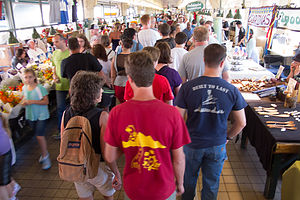 Lolo and Tom strolling Pike Place MarketThere were a lot of interesting sculptures to enjoy in the Park, but one of the most unusual ones for me was Heather Hart’s The Western Oracle: We Will Tear the Roof Off the Mother. This was not just a piece to look at, but one to interact with. From the upward side of the hill, it appeared as an independent rooftop without a house below. A roof alone is not too high, so I followed the tour guide’s encouragement to climb out on it. However, since the piece was built into the side of a hill, the view from the peak looking down and out over the Sound was a little bit more intimidating. Unfortunately, I had not read about this work before scampering about its roof, so I didn’t realize I could climb into the interior attic space. Reading about this piece now, I wish I did. The interior walls that hold the windows are made of Native elk drums, which are meant to beaten on, like a drum, to give them guidance and truth – hence the name The Western Oracle: We Will Tear the Roof Off the Mother.
Lolo and Tom strolling Pike Place MarketThere were a lot of interesting sculptures to enjoy in the Park, but one of the most unusual ones for me was Heather Hart’s The Western Oracle: We Will Tear the Roof Off the Mother. This was not just a piece to look at, but one to interact with. From the upward side of the hill, it appeared as an independent rooftop without a house below. A roof alone is not too high, so I followed the tour guide’s encouragement to climb out on it. However, since the piece was built into the side of a hill, the view from the peak looking down and out over the Sound was a little bit more intimidating. Unfortunately, I had not read about this work before scampering about its roof, so I didn’t realize I could climb into the interior attic space. Reading about this piece now, I wish I did. The interior walls that hold the windows are made of Native elk drums, which are meant to beaten on, like a drum, to give them guidance and truth – hence the name The Western Oracle: We Will Tear the Roof Off the Mother.
There were plenty more works to enjoy in the garden as well, by artists such as Richard Serra and Mark di Suvero. The Park was definitely a very enjoyable and worthwhile stop.
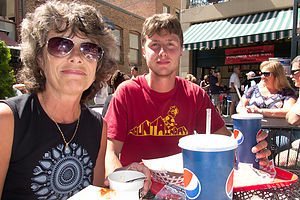 Lolo and Tom dining at Pike Place ChowderWe had accomplished so much already in our tour of Seattle, and we hadn’t even had lunch yet. That made our next stop absolutely perfect (and a bit overdue) -- Pike Place Market. I think that the image that comes to mind when people picture Seattle is probably the Space Needle, but not too far behind that is the huge, iconic red neon Public Market sign and the fishmongers throwing salmon. It was such a bustling place.
Lolo and Tom dining at Pike Place ChowderWe had accomplished so much already in our tour of Seattle, and we hadn’t even had lunch yet. That made our next stop absolutely perfect (and a bit overdue) -- Pike Place Market. I think that the image that comes to mind when people picture Seattle is probably the Space Needle, but not too far behind that is the huge, iconic red neon Public Market sign and the fishmongers throwing salmon. It was such a bustling place.
We started off walking through the upper level arcade, with its seemingly endless line of food and craft vendors. Hoping to see some fish tossing, we hung out for awhile near a fish vendor, but he must not have been in the mood. I would have to say that I never thought of watching people buy fish as a spectator sport before.
 Tom and Lolo at Gum AlleyWe were quite hungry, but there were so many places to choose from. As we often do, we used Yelp and found that Pike Place Chowder seemed to fit exactly what we were looking for. Despite the fact that it was mid-afternoon, and neither lunch nor dinner time, the line to order extended out onto the street. However, it moved quickly and it wasn’t long before we had our food and were seated at an outdoor table, where we could observe the action.
Tom and Lolo at Gum AlleyWe were quite hungry, but there were so many places to choose from. As we often do, we used Yelp and found that Pike Place Chowder seemed to fit exactly what we were looking for. Despite the fact that it was mid-afternoon, and neither lunch nor dinner time, the line to order extended out onto the street. However, it moved quickly and it wasn’t long before we had our food and were seated at an outdoor table, where we could observe the action.
We all chose to order a combo, which included one of their delicious specialty chowders and a half sandwich. We unanimously went for the Smoked Salmon Chowder. Why get New England Clam Chowder when in the heart of salmon country. Tommy and I got their famous Dungeness Crab Roll, which was absolutely delicious, but poor Herb, who is allergic to shellfish, got the Alder Smoked Salmon sandwich. Hard to feel sorry for him, because that was delicious as well.
After lunch, we strolled around a bit more and came upon the infamous Gum Alley. At first I wasn’t sure whether to classify this as disgusting or beautiful, but I eventually settled on beautiful. There is a fine line between litter and art. The entire length of the alley, from street level to 6 feet above, was totally covered with bubble gum of every shape and color. It was amazing.
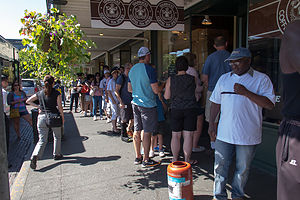 Line at the "Original" StarbucksBefore heading off for our next stop, we wanted to get a cup of coffee – and why not get one at the original Starbucks? I’ll tell you why not. Because the line extended halfway down the block, while a non-original Starbucks a short distance away had none.
Line at the "Original" StarbucksBefore heading off for our next stop, we wanted to get a cup of coffee – and why not get one at the original Starbucks? I’ll tell you why not. Because the line extended halfway down the block, while a non-original Starbucks a short distance away had none.
Our next and final activity of the day was biking the paved trail along Alki Beach in West Seattle. We parked our car on Harbor Avenue near Salty’s Restaurant and took our bikes off the car. The trail runs for about 2 ½ miles along the Elliott Bay shoreline paralleling Alki Avenue the whole way. This was a very nice neighborhood, which colorfully painted houses across from the beach. If I was to live in Seattle, I think this would probably be my top choice. While there were plenty of people out and about on the beach, playing volleyball and such, no one was in the water. Those chilly water temperatures really do make for a different beach experience than back East.
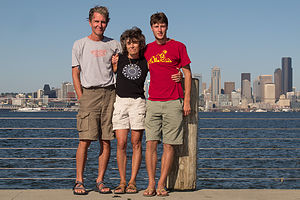 Herb, Lolo, and Tom on Alki Beach Bike PathWe found a Starbucks without a line wrapped around the block and very happily sat on a bench by the beach sipping our decadent ice mochas. Besides having the Puget Sound and the Olympic Mountains to look at, the Downtown Seattle skyline was right across the way.
Herb, Lolo, and Tom on Alki Beach Bike PathWe found a Starbucks without a line wrapped around the block and very happily sat on a bench by the beach sipping our decadent ice mochas. Besides having the Puget Sound and the Olympic Mountains to look at, the Downtown Seattle skyline was right across the way.
We continued to where the path ended at Alki Point before turning around and retracing our way back to the car.
It had been a busy day, but a very fun and productive one as well. I feel that we had gotten a good feel for the variety of places and activities that Seattle has to offer, and I felt very comfortable that Tommy would be very happy here. Also, it would be a great place to visit.
Day 2 – Shopping and Fireworks
There was a lot of nesting that had to be done to get Tommy settled in his new apartment in Seattle, so he and I decided to spend the day shopping while Herb stayed back and the campground doing maintenance on the RV.
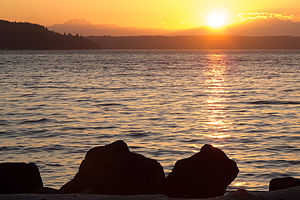 Saltwater State Park SunsetIt was 4th of July, but all the stores were open. First stop, Swedish meatballs and macaroni (at 10:00 am in the morning) at the Ikea Bistro. I had never had meatballs that early in the day, but they were pretty good, and the price was certainly right. Then we got down to business. By the end of the day, Tommy had bought a queen size bed and mattress, a dresser, an end table, and a desk. Rather than try to cram all this stuff into his car, we collectively decided it would be well worth the $60 to have it delivered.
Saltwater State Park SunsetIt was 4th of July, but all the stores were open. First stop, Swedish meatballs and macaroni (at 10:00 am in the morning) at the Ikea Bistro. I had never had meatballs that early in the day, but they were pretty good, and the price was certainly right. Then we got down to business. By the end of the day, Tommy had bought a queen size bed and mattress, a dresser, an end table, and a desk. Rather than try to cram all this stuff into his car, we collectively decided it would be well worth the $60 to have it delivered.
Then it was on to Bed Bath and Beyond, where we managed to spend another $300 to fully stock his kitchen and bathroom.
It was a very, very productive day including some great mother son bonding. We treated ourselves to another decadent Ice Mocha with whip cream at a Starbucks drive-thru and headed back to the campground to meet up with Herb. I had ordered a venti (large) with the intention of sharing it with Herb when we got back, but somehow there was only about a ½ inch left when we arrived. Those things have an awful lot of calories.
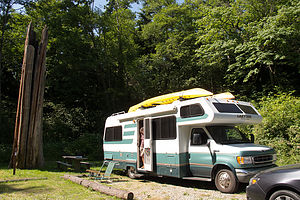 Camping at Saltwater State ParkWe had some time to kill before the fireworks that evening, so we went for a trail run within Saltwater State Park. The campground is located at the bottom of a ravine, so the trails were pretty steep and a little confusing to follow. Anyway, we did manage to get in some exercise and I was able to burn off probably about ¼ of the calories I consumed with that coffee.
Camping at Saltwater State ParkWe had some time to kill before the fireworks that evening, so we went for a trail run within Saltwater State Park. The campground is located at the bottom of a ravine, so the trails were pretty steep and a little confusing to follow. Anyway, we did manage to get in some exercise and I was able to burn off probably about ¼ of the calories I consumed with that coffee.
After dinner, we took our beach chairs down to the campground beach to set up to watch the fireworks. The beach is part of the park’s day use area, so it was already getting quite crowded. Once the fireworks got started, we actually wound up sitting on the rocks along the beach for a better view. It was a different fireworks experience than I am used to. Rather than being close to one fireworks display, we literally watched over a dozen displays in communities up and down the coastline and across on Vashon Island. There were so many places to look at the same time. It was a really nice way to bring our visit to Seattle to a close.
We said goodbye to Tommy, who headed back up to Seattle to spend the next few days settling in. I wasn’t too sad though because this wasn’t the official goodbye yet. We were all planning to meet up again in Bend, Oregon in a few days.
Description
We chose Saltwater State Park as our base camp from which to explore Seattle.
Saltwater State Park
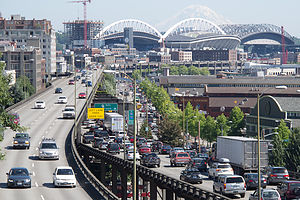 Mount Rainier view from Victor Steinbrueck ParkSaltwater State Park is an 88-acre marine camping park located about halfway between Seattle and Tacoma in the city of Des Moines, Washington. Its main attraction is its 1,445 feet of beachfront on the Puget Sound, including a sandy swimming beach, tide pools for exploring marine life, a submerged artificial reef popular with scuba divers, and salmon spawning in McSorley Creek. There is also a paved walking trail along the beach.
Mount Rainier view from Victor Steinbrueck ParkSaltwater State Park is an 88-acre marine camping park located about halfway between Seattle and Tacoma in the city of Des Moines, Washington. Its main attraction is its 1,445 feet of beachfront on the Puget Sound, including a sandy swimming beach, tide pools for exploring marine life, a submerged artificial reef popular with scuba divers, and salmon spawning in McSorley Creek. There is also a paved walking trail along the beach.
In addition to its waterfront section, the remainder of the park is nestled in a forested, steep ravine, with a network of hiking trails up to and along the surrounding ridges.
There is a 52-site, first-come first-served campground with no hookups. All sites are in McSorley Gulch along a road that parallels McSorley Creek.
The park is along the flight path for jets approaching SeaTac Airport, so it can get quite noisy at times. During certain hours, planes fly over the park every 15 minutes.
Seattle
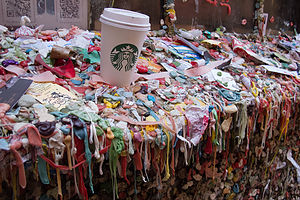 Gum AlleyOur stop in Seattle was brief, so this in no way is an attempt to give a thorough description of what to see in the city. However, the following sites are what we chose to do during our all too short one day visit.
Gum AlleyOur stop in Seattle was brief, so this in no way is an attempt to give a thorough description of what to see in the city. However, the following sites are what we chose to do during our all too short one day visit.
Green Lake Park is a favorite amongst Seattleites who come here to enjoy its 342 acres of water and green space. Located in the center of a dense urban area, it draws thousands of people daily to swim, bike, jog, skate, stroll, boat, walk their dogs, or just sit on a blanket and people watch. There are two swimming beaches, one on the east side and one on the west, with lifeguards and swimming rafts. Green Lake Boat Rental, on the eastern side of the lake, rents paddleboats, kayaks, and canoes. A 2.8 mile paved trail circles the lake and is often crowded with strollers, bikes, bladders, and joggers. In addition, there are playgrounds, basketball and tennis courts, and athletic fields for baseball and soccer.
Golden Gardens Park, located in Ballard on Puget Sound, is a popular destination for Seattle beachgoers. While the waters are quite chilly for swimming, the extraordinary views of Puget Sound and the Olympic Mountains from its sandy beach make it a lovely spot to spend the day. The park also has two wetlands, a short loop trail, and a fishing pier. Watching the sunset over the sound gathered around a bonfire is another popular activity.
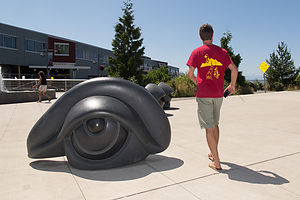 Tom with Louise Bourgeois' Eye BenchesDiscovery Park’s 534 acres makes it Seattle’s largest park. It is located in the Magnolia/Queen Anne district of Seattle. The park has a wide variety of terrain, including two miles of protected tidal beaches, active sand dunes, dramatic sea cliffs, meadows and forests, and a lighthouse. The more than 11 miles of trails includes routes along the beach and up and along the bluffs. From atop Magnolia Bluff, the views of Puget Sound and the surrounding Olympic and Cascade mountain ranges are spectacular. Maps and suggested walking/hiking routes are available at the Discovery Park Visitor Center.
Tom with Louise Bourgeois' Eye BenchesDiscovery Park’s 534 acres makes it Seattle’s largest park. It is located in the Magnolia/Queen Anne district of Seattle. The park has a wide variety of terrain, including two miles of protected tidal beaches, active sand dunes, dramatic sea cliffs, meadows and forests, and a lighthouse. The more than 11 miles of trails includes routes along the beach and up and along the bluffs. From atop Magnolia Bluff, the views of Puget Sound and the surrounding Olympic and Cascade mountain ranges are spectacular. Maps and suggested walking/hiking routes are available at the Discovery Park Visitor Center.
Hiram M. Chittenden Locks is one of the most visited attractions in Seattle. The locks provide passage for boats along an 8-mile canal connecting Puget Sound with freshwater Lake Union and Lake Washington. Visitors can watch the parade of boats, tugs, and barges pass through the locks, as the water level is adjusted to allow them through. Another popular attraction is the fish ladder, built to allow salmon to migrate back to freshwater to spawn. An underwater fish-viewing window provides visitors with the opportunity to view several species of salmon and trout make their way back upstream. There is also a lovely botanical garden to stroll through.
The Olympic Sculpture Park is a nine-acre waterfront park that was transformed from an industrial site into an open space for art. The grounds, which are part of the Seattle Art Museum, are home for works by such artists as Alexander Calder, Richard Serra, and Mark di Suvero. On clear days there are stunning views of the Olympic Mountains and Puget Sound. Admission is free.
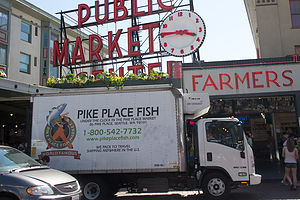 Pike Place Market SignPike Place Market is one of the nation’s largest and oldest public markets. Founded in 1907, it has now become one of Seattle’s most famous and popular attractions, hosting over 10 million visitors each year. Perched atop Pike Hill overlooking Elliot Bay, the nine-acre market district consists of several levels, offering fresh produce, unique foods, handmade arts and crafts, restaurants, the first Starbucks, numerous talented street performers, and even one of the oldest head shops in the country. However, the most popular section is the upper level, pedestrian-friendly covered arcade, with its iconic huge red neon sign and fishmongers tossing salmon to the cheers of the expectant crowd.
Pike Place Market SignPike Place Market is one of the nation’s largest and oldest public markets. Founded in 1907, it has now become one of Seattle’s most famous and popular attractions, hosting over 10 million visitors each year. Perched atop Pike Hill overlooking Elliot Bay, the nine-acre market district consists of several levels, offering fresh produce, unique foods, handmade arts and crafts, restaurants, the first Starbucks, numerous talented street performers, and even one of the oldest head shops in the country. However, the most popular section is the upper level, pedestrian-friendly covered arcade, with its iconic huge red neon sign and fishmongers tossing salmon to the cheers of the expectant crowd.
Alki Beach is a 2 ½ mile stretch of sand in West Seattle that runs from Alki Point to Duwamish Head on Elliott Bay. While few brave the chilly waters (temperature ranges from 46 to 56 degrees), the beach is popular for sunbathing and enjoying the spectacular views of Puget Sound, the Olympic Mountains, and the Downtown Seattle skyline. A paved bicycle path, which runs the whole length of the beach, is a hot spot for bicyclists, rollerbladers, joggers, and walkers.
- ‹ previous
- 8 of 15
- next ›
Seattle location map in "high definition"
Javascript is required to view this map.
